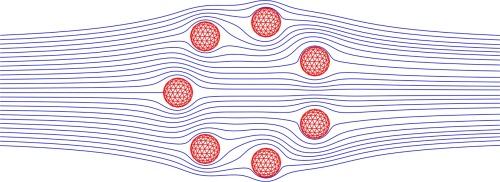The method of fundamental solutions for multi-particle Stokes flows: Application to a ring-like array of spheres
IF 3.8
2区 物理与天体物理
Q2 COMPUTER SCIENCE, INTERDISCIPLINARY APPLICATIONS
引用次数: 0
Abstract
A method is presented for calculating Stokes flow around multiple particles of arbitrary shape. It uses the Method of Fundamental Solutions (MFS) applied to single particles, combined with an iterative scheme to resolve the many particle-particle hydrodynamic interactions; an approach that is reminiscent of the Method of Reflections. The attractive features of the proposed method are inherited from the MFS — simplicity and accuracy — while providing orders of magnitude computational speed-up for large particle systems. The method is verified through a series of test cases, including those involving strong lubrication forces and non-spherical particles. Unlike applications of the Method of Reflections reported in the literature, the iterative scheme we propose (a block Gauss-Seidel approach to solving a particle-particle interaction matrix) converges for all the cases we consider, for both resistance and mobility problems. The scheme is applied to the study of Stokes flow around ring-like arrays of spheres. We show that the relationship between globally applied velocity or force to the response of individual spheres can be described by just 5 coefficients (or 9 in total) for any given configuration. The results indicate that for 7–10 spheres in sedimentation, there exists a certain spacing that produces steady-state translation of the ring, independent of its orientation. For large numbers of spheres, slender-body theory can be applied to the problem, providing remarkably close agreement to the numerical results over a wide range of parameters.

多粒子斯托克斯流的基本解法:对环状球阵列的应用
本文介绍了一种计算任意形状的多个粒子周围斯托克斯流的方法。该方法采用了适用于单个粒子的基本解法(MFS),并结合迭代方案来解决许多粒子间的流体动力学相互作用;这种方法让人想起反射法(Method of Reflections)。所提出的方法继承了 MFS 的诱人特点--简单、准确,同时为大型粒子系统提供了数量级的计算速度。通过一系列测试案例,包括涉及强润滑力和非球形粒子的案例,对该方法进行了验证。与文献中报道的反射法应用不同,我们提出的迭代方案(求解粒子-粒子相互作用矩阵的分块高斯-赛德尔方法)在我们考虑的所有情况下,无论是阻力问题还是流动性问题,都能收敛。我们将该方案应用于研究环状球阵列周围的斯托克斯流。我们发现,对于任何给定配置,全局施加的速度或力与单个球体响应之间的关系只需 5 个系数(或总共 9 个系数)即可描述。结果表明,对于沉积中的 7-10 个球体,存在一定的间距,可以产生与环的方向无关的稳态平移。对于大量的球体,细长体理论可应用于该问题,在广泛的参数范围内与数值结果非常接近。
本文章由计算机程序翻译,如有差异,请以英文原文为准。
求助全文
约1分钟内获得全文
求助全文
来源期刊

Journal of Computational Physics
物理-计算机:跨学科应用
CiteScore
7.60
自引率
14.60%
发文量
763
审稿时长
5.8 months
期刊介绍:
Journal of Computational Physics thoroughly treats the computational aspects of physical problems, presenting techniques for the numerical solution of mathematical equations arising in all areas of physics. The journal seeks to emphasize methods that cross disciplinary boundaries.
The Journal of Computational Physics also publishes short notes of 4 pages or less (including figures, tables, and references but excluding title pages). Letters to the Editor commenting on articles already published in this Journal will also be considered. Neither notes nor letters should have an abstract.
 求助内容:
求助内容: 应助结果提醒方式:
应助结果提醒方式:


